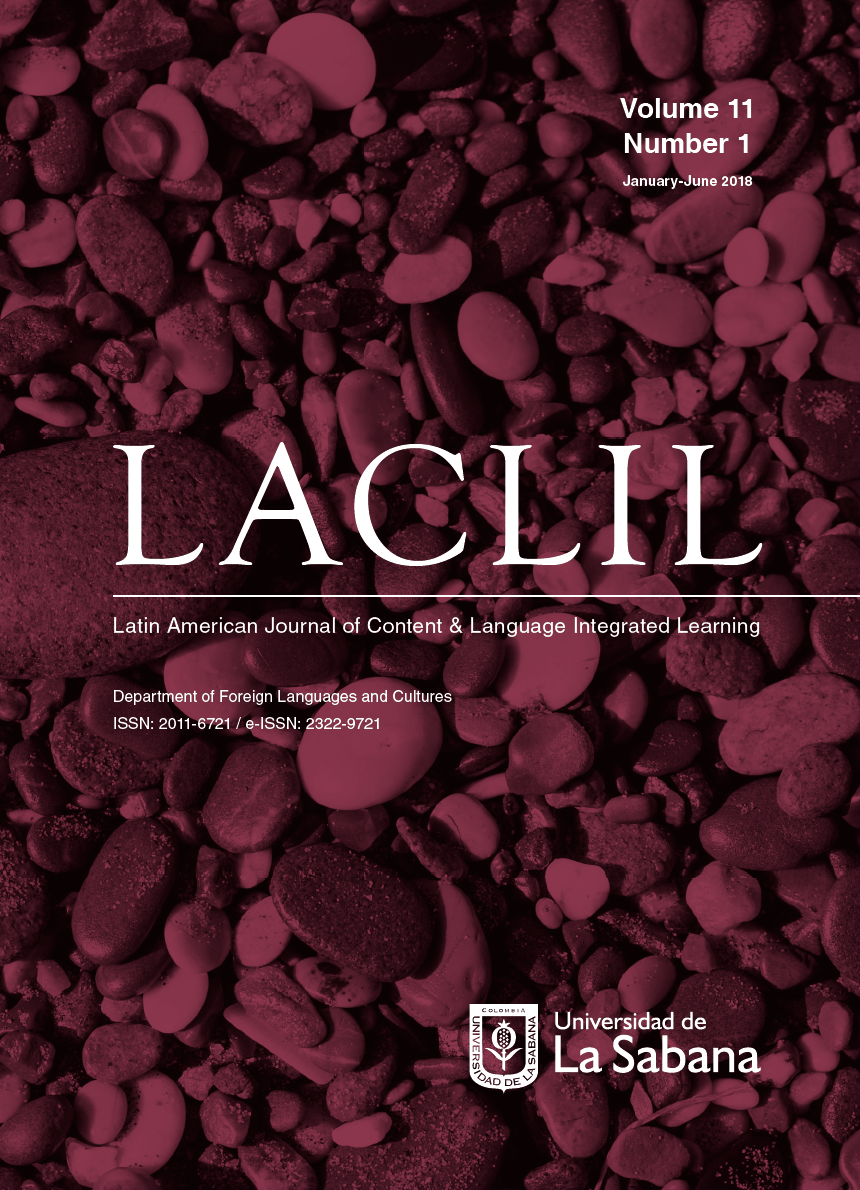AICLE en el currículo: beneficios que van más allá del aula
Palabras clave:
CLIL, Curriculum, CBI, Content Based Curriculum, HOTS, LOTS, CALP, BICSDescargas
Citas
Alcaraz-Mármol, G. (2018). Trained and non-trained language teachers on CLIL methodology: teachers’ facts and opinions about the CLIL approach in the primary education context in Spain. Latin American Journal of Content & Language Integrated Learning, 11(1), 39-64. doi: 10.5294/laclil.2018.11.1.3
Anderson, C. E. (2011). CLIL for CALP in the multilingual, pluricultural, globalized knowledge society: Experiences and backgrounds to L2 English usage among Latin American L1 Spanish-users. Latin American Journal of Content and Language Integrated Learning, 4(2), 51–66. doi: 10.5294/laclil.2011.4.2.5
Argudo, J., Abad, M., Fajardo-Dack, T., & Cabrera, P. (2018). Analyzing a pre-service EFL program through the lenses of the CLIL (Content and Language Integrated Learning) approach at Universidad de Cuenca, Ecuador. Latin American Journal of Content & Language Integrated Learning, 11(1), 65-86. doi: 10.5294/laclil.2018.11.1.4
Bellés-Calvera, L. (2018). Teaching Music in English: A Content-Based Instruction Model in Secondary Education. Latin American Journal of Content & Language Integrated Learning, 11(1), 109-139. doi: 10.5294/ laclil.2018.11.1.6
Cenoz, J. (2015). Content-based instruction and content and language integrated learning: the same or different? Language, Culture and Curriculum. doi: 10.1080/07908318.2014.1000922
Coyle, D., Hood, P., & Marsh, D. (2010). CLIL. Cambridge: Cambridge University Press.
Cummins, J. (1989). Theoretical Background. TESOL Quarterly Article Stable URL. doi: 10.1007/978-3-642-27526-5_2
Cummins, J. (2000). Language Proficiency in Academic Contexts Evolution of the Conversational/Academic Language Proficiency Distinction. In Language, Power, and Pedagogy.
Deyrich, M.-C., & Stunnel, K. (2014). Language education models: New issues and challenges. In English as a foreign language teacher education: Current perspectives and challenges (p. 364).
Görlach, M. (1999). David Graddol, The Future of English? A Guide to Forecasting the Popularity of the English Language in the 21st Century I>. English World-Wide. 10.1075/eww.20.1.11gor
Graham, K. M., Choi, Y., Davoodi, A., Shakiba, R., & Dixon, L. Q. (2018). Language and content outcomes of CLIL and EMI: a systematic review. Latin American Journal of Content & Language Integrated Learning, 11(1), 19-37. doi: 10.5294/laclil.2018.11.1.2
Granados, J. (2018). The Challenges of Higher Education in the 21st Century. Retrieved September 1, 2018, from http://www.guninetwork.org/ articles/challenges-higher-education-21st-century
Halbach, A. (2012). Questions about basic interpersonal communication skills and cognitive language proficiency. Applied Linguistics. doi: 10.1093/applin/ams058
Jarson, J. (2010). Information literacy and higher education: A toolkit for curricular integration. College & Research Libraries News, 71(10), 534–538.
Khatib, M., & Taie, M. (2016). BICS and CALP: Implications for SLA. Journal of Language Teaching and Research, 7(2), 382. doi: 10.17507/jltr.0702.19
Meyer, O., Coyle, D., Halbach, A., Schuck, K., & Ting, T. (2015). A pluriliteracies approach to content and language integrated learning- Mapping learner progressions in knowledge construction and meaning-making. Language, Culture and Curriculum, 28(1). doi: 10.1080/07908318.2014.1000924
Pinner, R. (2013). Authenticity and CLIL: Examining Authenticity from an International CLIL Perspective. International CLIL Research Journal.
Popović, D. (2014). Guest editor´s introduction: The challenges students are facing in the 21st century. Singidunum Journal of Applied Linguistics, 11(1), 1–4.
Reitbauer, M., Fürstenberg, U., Kletzenbauer, P., & Marko, K. (2018). Towards a cognitive-linguistic turn in CLIL: unfolding integration. Latin American Journal of Content & Language Integrated Learning, 11(1), 87-107. doi: 10.5294/laclil.2018.11.1.5
Robinson, K. (2001). Mind the gap: The creative conundrum. Critical Quarterly, 43(1), 41–45. doi: 10.1111/1467-8705.00335
Robinson, K. (2011). Out of our minds: Learning to be creative (2nd ed.). Chichester, UK: Capstone/John Wiley & Sons. Retrieved from http://www. amazon.com/Out-Our-Minds-Learning-Creative-ebook/dp/B005CKKETU/
Robinson, K., & Aronica, L. (2009). The element: How finding your passion changes everything. London, UK: Allen Lane.
Robinson, K., Minkin, L., & Bolton, E. (1999). All Our Futures : Creativity , Culture and Education. National Advisory Committee on Creative and Cultural Education. doi: 10.1075/prag.22.3.02gre
Sarasa, M. C., & Porta, L. G. (2018). Narratives of desire, love, imagination, and fluidity: becoming an English teacher in a university preparation program. Latin American Journal of Content & Language Integrated Learning, 11(11), 141-163. doi: 10.5294/laclil.2018.11.1.7
UNESCO. (2018). Internacional Bureau of Education. Available from http:// www.ibe.unesco.org/en/ibe-alert/12-july-2018
Várkuti, A. (2010). Linguistic Benefits of the CLIL Approach: Measuring Linguistic Competences. International CLIL Research Journal, 1(3), 67-79. Available from http://www.icrj.eu/13/article7.html
Vázquez, V. P., & Gaustad, M. (2013). Designing Bilingual Programmes for Higher Education in Spain : Organisational , Curricular and Methodological Decisions, 2(1), 82–94.
Descargas
Publicado
Cómo citar
Número
Sección
Licencia
Los autores que publican en esta revista están de acuerdo con los siguientes términos:
Esta revista y sus artículos se publican bajo la licencia Creative Commons Atribución-NoComercial-SinDerivadas 4.0 Internacional (CC BY-NC-ND 4.0), por lo cual el usuario es libre de: compartir, copiar y redistribuir el material en cualquier medio o formato, siempre y cuando: dé crédito de manera adecuada, brinde un enlace a la licencia e indique si se han realizado cambios; no use nuestro contenido con propósitos comerciales; y/o remezcle o transforme el material. Recuerde que no tiene los permisos para distribuir el material si fue modificado.




